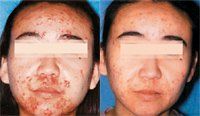- General Dermatology
- Eczema
- Chronic Hand Eczema
- Alopecia
- Aesthetics
- Vitiligo
- COVID-19
- Actinic Keratosis
- Precision Medicine and Biologics
- Rare Disease
- Wound Care
- Rosacea
- Psoriasis
- Psoriatic Arthritis
- Atopic Dermatitis
- Melasma
- NP and PA
- Skin Cancer
- Hidradenitis Suppurativa
- Drug Watch
- Pigmentary Disorders
- Acne
- Pediatric Dermatology
- Practice Management
- Prurigo Nodularis
Article
Acne issues in men treatable with topical, laser therapies
The incidence of acne in adult men is not as common as it is in female patients, but, nevertheless, some men do seek acne treatment from dermatologists, according to Vic A. Narurkar, M.D., F.A.A.D., founder and director, Bay Area Laser Institute, San Francisco. Adult men usually do not seek treatment for acne as frequently as they do for other conditions, such as rosacea.

Key Points

Adult men usually do not seek treatment for acne as frequently as they do for other conditions, such as rosacea.
"I see a much higher incidence of rosacea bringing in male patients than adult acne," Dr. Narurkar says.
Dr. Narurkar says he treats more women than men with adult acne. There are numerous differences between male and female adult acne.
"I have found that adult men who present with acne usually have a history of acne as teenagers, which is not necessarily the case in women," he says.
Acne in men is thought to be genetic, while acne in women is more likely to be related to hormones.
"We find with women, they are coming in with hormonally mediated acne. They see flares around the time of their menstrual cycles. Male acne is obviously not hormonal," he says. "It probably more genetic than anything else and it tends to respond better to conventional treatments. Acne in adult women is much more challenging than in adult men."
Typically with men, a greater incidence of acne occurs on the back and chest than acne in female patients.
"This often gets mistaken for folliculitis when it is actually acne," Dr. Narurkar says.
Treatment options

"Retinoids are my mainstay of treatment for adult acne in both men and women," he says. "Men usually tolerate topical retinoids better and I will utilize agents such as Tazorac (tazarotene 0.1 percent, Allergan) and Retin-A-Micro (tretinoin 0.04 percent/0.1 percent, Ortho Dermatologics) to be used nightly.
"If they do not respond to topicals after six to eight weeks, I will go to oral antibiotics, such as those in the tetracycline family, including doxycycline or minocycline. If they don't respond to these medications after six to eight weeks, I will move to another line of treatment."
More dermatologists are turning to laser therapies for men with adult acne because of its benefits and convenience, Dr. Narurkar says.
"With the laser there is not a lot of downtime," he says. "For example, we use the Isolaz device (Solta Medical) which is an acne light treatment that cleanses the pores to eject the sebum and delivers a broadband blue-green pulsed light that kill the bacteria. Men, particularly, have a hyperproduction of sebum, so they get that benefit as well."
The Isolaz acne light treatment is indicated to treat benign vascular and pigmented lesions; mild-to-moderate acne, including pustular acne, comedonal acne and mild-to-moderate acne vulgaris in all skin types; and for permanent hair reduction.
Other alternatives
Compliance is often an issue with male patients, perhaps more so than with women, Dr. Narurkar says.
"With men because of behavioral characteristics, compliance is often a bit more challenging than with women. I find that my adult women acne patients will tend to be much more compliant with regimens than men will," he says.
Dermatologists also need to differentiate between other conditions in men that might appear to be acne. For example, pseudofolliculitis barbae, a foreign-body inflammatory reaction surrounding ingrown facial hair, results from shaving.
"Pseudofolliculitis barbae is very common in men in the beard area, so if dermatologists see that they should recognize it and treat it appropriately with a combination of laser hair reduction and topical antibiotic therapy," he says.
Disclosures: Dr. Narurkar has performed clinical trials for Allergan, Palomar and Solta Medical.





